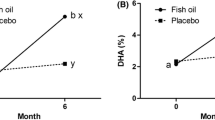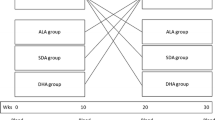Abstract
To manage dyslipidemia using diet recommendations based on argan oil consumption, we were interested in studying, for the first time, the effect of argan oil consumption on plasma lipids in never-treated Moroccan dyslipidemic patients. Twenty-four dyslipidemic patients from the endocrinology department of University Hospital of Rabat (Morocco) were included in this interventional study. The study design consists to two diet periods. In the first diet period of 2 weeks, all patients consumed 20 g/day of butter in breakfast. In the second period of 3 weeks (nutritional intervention), all patients were randomized to two diet groups: one group of 15 patients in which the 20 g/day of butter was substituted by 25 ml/day of argan oil with toasted bread for breakfast. The second group of nine patients for whom, both argan oil and olive oil were removed from their diet while keeping the 20 g/day of butter for breakfast. During this period, all patients were placed under a lifestyle and diet recommended for the dyslipidemic patient as reported by the French Agency for Health Products Safety (AFSSAPS). Serum lipid [total cholesterol (total-chol), triglycerides, low density lipoprotein cholesterol (LDL-chol) and high density lipoprotein cholesterol (HDL-chol)] and anthropometric parameters were measured at the end of both periods. Both groups of patients have showed an improvement of lipid parameters in the end of the interventional period compared to the end of stabilization period by reducing total-chol and LDL-chol; and triglycerides and increasing HDL-chol. However, the change in atherogenic lipids was significantly different (P < 0.04) in the consumers group of argan oil compared to the control group; 30 versus 14% for total-chol, 46 versus 24.5% for triglycerides, 24 versus 15% for LDL-chol, respectively. While the increase in HDL-chol in consumers group of argan oil was different but not significantly compared to the control group; 17 versus 14% (P = 0.1). We have demonstrated for the first time that consumption of argan oil improves the lipid status in never-treated patients with dyslipidemia and can therefore be recommended in nutritional prevention in the management of dyslipidemia.


Similar content being viewed by others
References
Omelchenko A (2009) A lead as an environmental cardiovascular risk factor. Period Biol 1:91–98
El Ayachi M, Mziwira M, Vincent S et al (2005) Lipoprotein profile and prevalence of cardiovascular risk factors in urban Moroccan women. Eur J Clin Nutr 12:1379–1386
Cicero AFG, Derosa G, Bove M, Imola F, Borghi C, Gaddi AV (2010) Psyllium improves dyslipidaemia, hyperglycaemia and hypertension, while guar gum reduces body weight more rapidly in patients affected by metabolic syndrome following an AHA Step 2 diet. Mediterr J Nutr Metab 3:47–54
Kromhout D, Menotti A, Kesteloot H, Sans S (2002) Prevention of coronary heart disease by diet and lifestyle. Circulation 105:893–898
Herold PM, Kinsella JE (1986) Fish oil consumption and decreased risk of cardiovascular diseases: a comparison of findings from animal and human feeding trials. Am J Clin Nutr 43:566–598
Karatayev O, Gaysinskaya V, Chang GQ, Leibowitz SF (2009) Circulating triglycerids after a high-fat meal: predictor of increased caloric intake, orexigenic peptide expression, and dietary obesity. Brain Res 1298:111–122
Kagan A, Harris BR, Winkelstein W Jr et al (1974) Epidemiologic studies of coronary heart disease and stroke in Japanese men living in Japan, Hawaii and California: demographic, physical, dietary and biochemical characteristics. J Chronic Dis 27:345–364
Posner BM, Cobb JL, Belanger AJ, Cupples LA, D’Agostino RB, Stokes J 3rd (1991) Dietary lipid predictors of coronary heart disease in Men. Arch Intern Med 151:1181–1187
Shekel RB, MacMillan SA, Oglesby P et al (1981) Diet, serum cholesterol. The western electric study. N Engl J Med 304:65–70
Khallouki F, Younos C, Soulimani R et al (2003) Consumption of argan oil (Morocco) with its unique profile of fatty acids tocopherols, squalene, sterols, and phenolic compounds should confer valuable cancer chemo-preventive effects. Eur J Cancer Prev 12:67–75
Berrada Y, Settaf A, Baddouri K, Cherrah A, Hassar M (2000) Experimental evidence of an antihypertensive and hypocholesterolemic effect of oil of organ, Argania sideroxylon. Therapie 55:375–378
Berrougui H, Ettaib A, Herrera Gonzalez MD, de Alvarez sotomayor M, Bennani-Kabchi N, Hmamouchi M (2003) Hypolipidemic and hypocholesterolemic effect of Argan oil in Meriones shawi rats. J Ethnopharmacol 89:15–18
Berrougui H, Alvarez de sotomayor M et al (2004) Argan (argania spinosa) oil lowers blood pressure and improves endothelial dysfunction in spontaneously hypertensive rats. Br J Nutr 92:921–929
Drissi A, Girona J, Cherki M et al (2004) Evidence of hypolipemiant and antioxidant properties of argan oil derived from the argan tree (argania spinosa). Clin Nutr 23:1159–1166
Derouiche A, Cherki M, Drissi A et al (2005) Nutrition intervention study with argan oil in man: effects on lipids and apolipoproteines. Ann Nutr Metab 49:196–201
Richmond N (1973) Preparation and properties of a cholesterol oxidase from Nocardia sp. and its application to the enzymatic assay of total cholesterol in serum. J Clin Chem 19:1350–1356
Friedewald WT, Levy RI, Fredrickson DS (1972) Estimation of the concentration of low-density lipoprotein cholesterol in plasma, without use of the preparative ultracentrifuge. Clin Chem 18:499–502
Trinder P (1969) Enzymatic method of triglycerides. Ann Clin Biochem 6:24–27
Samane S, Christon R, Dombrowski L et al (2009) Fish oil and argan oil intake differently modulate insulin resistance and glucose intolerance in a rat model of dietary induced obesity. Metabolism Clin Exp 58:909–919
Miller N (1978) The evidence for the anti-atherogenecity of HDL in man. Symposium on HDL structure function analysis, clinical, epidemiological aspect of HDL. Lipids 13:914–918
Sola R, Baudet M, Motta C (1993) Dietary monounsaturated fatty acids enhance cholesterol efflux from fibroblasts. Relation to fluidity, phospholipid fatty acid composition, overall composition and size of HDL3. Arterioscler Thromb 13:958–966
Sola R, Baudet MF, Motta C, Maille M, Boisnier C, Jacotot B (1990) Effects of dietary fats on the fluidity of human high-density lipoprotein: influence of the overall composition and phospholipid fatty acids. Biochim Biophys Acta 1043:43–51
Frank B, Hu M, Meir J et al (1997) Dietary fat intake and the risk of coronary heart disease in women. N Engl J Med 337:1491–1499
Trautwein EA, Rieckhoff D, Kunath-Rau A, Erbersdobler HF (1999) Replacing saturated fat with PUFA-rich (sunflower oil) or MUFA-rich (rapeseed, olive and high-oleic sunflower oil) fats resulted in comparable hypocholesterolemic effects in cholesterol-fed hamsters. Ann Nutr Metab 43:159–172
Keys A, Minotti A, Karvonen MJ (1996) The diet and 15-year death rate in the Seven Countries study. Am J Epidemiol 124:903–915
Lin He MS, Maria LF (1998) Saturated fat and simple carbohydrates elevate plasma LDL cholesterol concentrations by specific alterations on hepatic cholesterol metabolism. Nutrition Research 18:1003–1015
Richard JL, Marin C, Maille M, Mendy F, Delolanque B, Jacotot B (1990) Effect of dietary intake of gamma linolenique acid on blood lipids and phospholipid fatty acids in healthy human subject. J Clin Biochem Nutr 8:75–84
Atikah FD, Siddik N, Sembiring TB, Ariani A (2009) The effect of dietary intervention and physical activities on the lipid profile of obese children. Pediatr Indones 2:108–111
Cecilia B, Rosalba S, Tiziana A (1998) Free fatty acids modulate LDL receptor activity in BHK-21 cells. Atherosclerosis 137:329–340
Adlouni A, Cherki M, Khalil A, El Messal M (2009) Argan oil may reduce cardiovascular risk associated with obesity. Atherosclerosis 10:385
Nagyova A, Haban P, Klvanova J, Kadrabova J (2003) Effects of dietary extra virgin olive oil on serum lipid resistance to oxidation and fatty acid composition in elderly lipidemic patients. Bratisl Lek Listy 104:218–221
Heinemann T, Axtmann G, Von Bergmann K (1993) Comparison of intestinal absorption of cholesterol with different plant sterol in man. Eur J Clin Invest 23:827–831
Khandelwal S, Demonty I, Jeemon P (2009) Independent and interactive effects of plant sterols and fish oil n-3 long-chain polyunsaturated fatty acids on the plasma lipid profile of mildly hyperlipidaemic Indian adults. Br J Nutr 102:722–732
Demonty I, Ras RT, van der Knaap HC, Duchateau GS, Meijer L, Zock PL, Geleijnse JM, Trautwein EA (2009) Continuous dose-response relationship of the LDL-cholesterol–lowering effect of phytosterol intake. J Nutr 2:271–284
Marangoni F, Poli A (2010) Phytosterols and cardiovascular health. Pharmacol Res 61:193–199
Varady KA, St Pierre AC, Lamarche B, Jones PJH (2005) Effect of plant sterols and endurance training on LDL particle size and distribution in previously sedentary hypercholesterolemic adults. Eur J Clin Nutr 59:518–525
Malinowski JM, Gehret MM (2010) Phytosterols for dyslipidemia. Am J Health Syst Pharm 14:1165–1173
Acknowledgments
The authors gratefully would like to thank Zakaria Ouissafane, the Argan oil Company Director for his contribution of argan oil needed in the study. Also, our thanks are given to Agrotech Association SMD for their financial support and to Dr A. Belhouari for his statistical analysis.
Conflict of interest
None.
Author information
Authors and Affiliations
Corresponding author
About this article
Cite this article
Ould Mohamedou, M.M., Tacha, A., El Messal, M. et al. The consumption of argan oil induces a lipid-lowering effect in dyslipidemic patients. Mediterr J Nutr Metab 5, 143–147 (2012). https://doi.org/10.1007/s12349-011-0080-9
Received:
Accepted:
Published:
Issue Date:
DOI: https://doi.org/10.1007/s12349-011-0080-9




